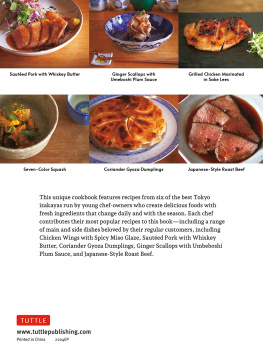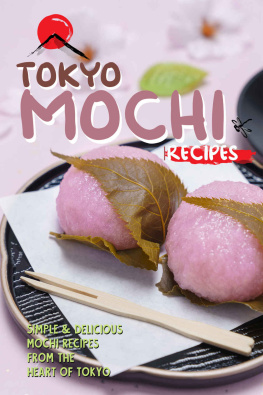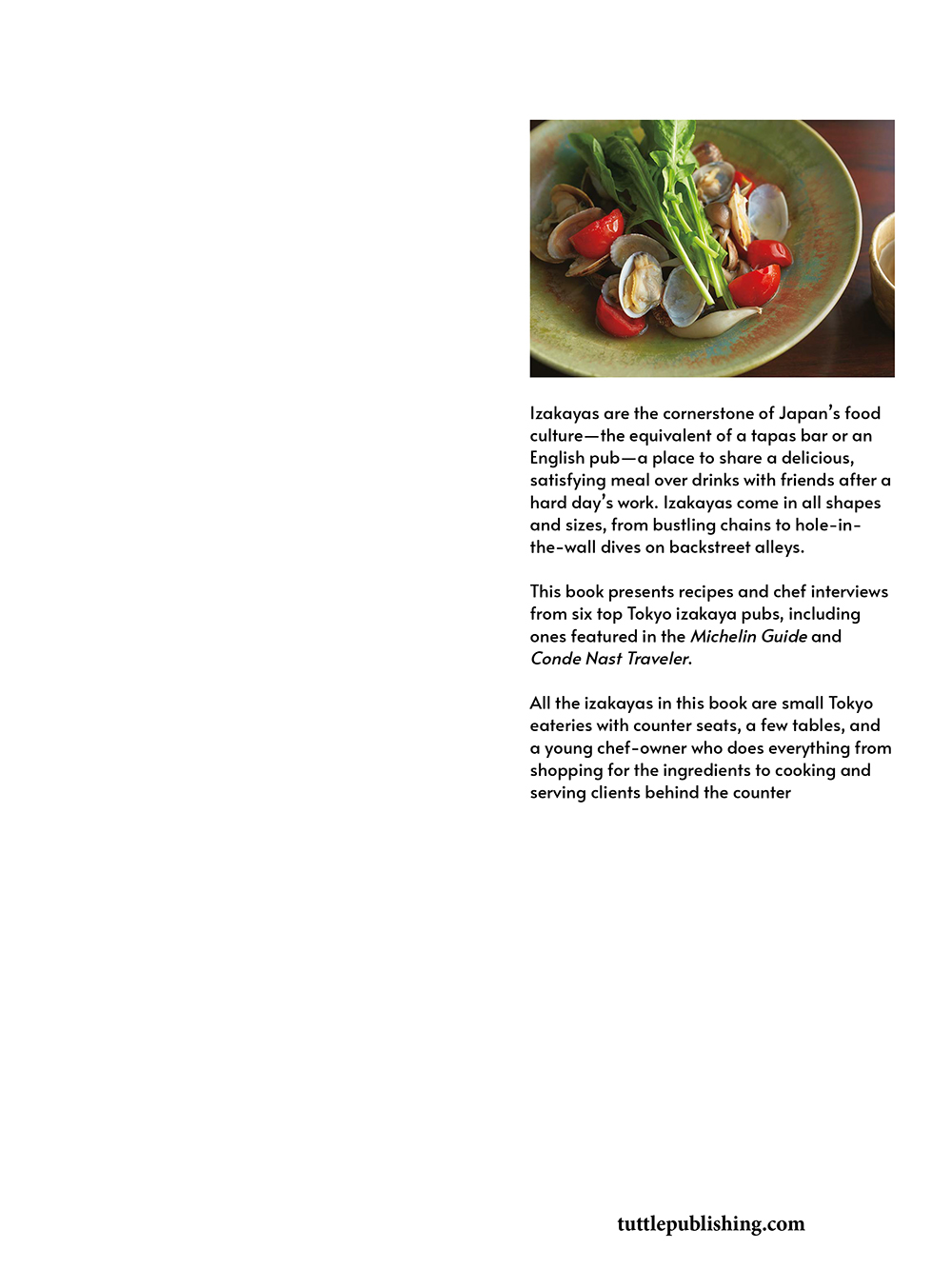NIHONSHU-YA SAKEBOZU SHUTEI ZOROME
SHUKO TAKIGIYA AMETSUCHI KOTARO
Tokyo
Izakaya
Delicious Pub Recipes from Six Popular Tokyo Eateries
Contents
Chicken and Cucumber with Sesame
Dressing 14
Sesame-Scented Myoga Ginger and
Whitebait 15
Chicken Gizzards and Green Beans with
Sesame 20
Pork Shabu-Shabu Hot Pot with Umeboshi
Plum 22
Deep-Fried Sea Eel with Shibazuke Tartar
Sauce 26
Wood-Ear Mushrooms and Cucumber in
Leek-Oil Dressing 91
Pork Shabu-Shabu Hot Pot with Spicy Daikon
Radish 98
Steamed Clams and Tomatoes with Thai Fish
Sauce 101
The World of Izakaya
Across Japan, often down quiet side streets, you can find small izakayas, furnished
with a counter and just a few tables. The owner takes care of everything behind the
counter, doing everything on their own, from selecting the basic ingredients to cre
ating the menu, paying careful attention to detail at every step. The dishes served at
such places are often simple, yet they have great depth of flavor, and unique meth
ods may be used to prepare the ingredients.
In this book, we have asked the owner-chefs of several popular small izakaya in
Tokyo of the type described above to show us otsumami small plates to go with
drinksthat can be made easily in a home kitchen. Their recipes not only show how
to prepare and cook the ingredients, but are also filled with points on the funda
mentals of cooking that only a professional can impart. They also give tips on how
to elevate your home cooking in general.
Tasty, thoughtfully prepared dishes make drinks taste so much better. If youre
thinking, What should I have with my drink today? you will find the answer here.
We hope that this book will make drinking at home that much more enjoyable.
The Izakayas and Their Chefs
Kotaro
Ametsuchi
Shuko Takigiya
Chefs name: Kotaro Hayashi
Chef Hayashi creates
approachable, innovative
dishes using classic Japanese
izakaya items as his jumping
off point ().
Chefs name: Miho Tsuchii
Chef Tsuchiis simply cooked
dishes bring out the full
character of the ingredients
she uses. Their gentle flavors
impart a feeling of comfort and
well-being ().
Chefs name: Hiroto Kobayashi
Chef Kobayashis straightfor
ward small-plate dishes
adhere to a consistent
foundation of excellence,
regardless of the ingredient
().
Shutei Zorome
Sakebozu
Nihonshu-ya
Chefs name: Hisato Ono
Great attention to fine detail
is evident in all aspects of the
unique, fun dishes that Chef
Ono creates ().
Chefs name: Tomo Maeda
Chef Maeda excels in the use
of spices as hidden accents.
His unique approach shines in
his combination of ingredients
and cooking methods
().
Chefs name: Kenichi Takaya
Chef Takaya is filled with ideas
that are novel, but not over the
top. This can be seen in the
way he makes Japanese and
Western flavors and cooking
methods harmonize with each
other ().
Glossary of Ingredients
Abura-age tofu
Abura-age is a deep-fried tofu
pouch,
available at
Japanese
grocery
stores. A
deep-fried
tofu product
often called tofu puffs, available
at general Asian or Chinese
grocery stores, can be substituted
in recipes that call for abura-age.
Aonori seaweed powder
This is a versatile ingredient that
adds color and variety. Available at
Japanese grocery stores or online.
Use crazy salt if you cant get hold
of aonori.
Bonito flakes
Called katsuobushi in Japanese,
these are flakes of fermented,
dried and aged skipjack tuna or
bonito. It is an essential ingredient
in Japanese cooking, used to
make dashi or Japanese stock,
and also as a garnish or topping.
The size of the flakes ranges from
very fine and powder-like to large,
long shavings that look like wood
shavings. Available at Japanese
grocery stores or online.
Burdock root
The distinctive crunchy texture
and earthy flavor really whet the
appetite. You can find burdock
root for sale at East Asian grocery
stores. If you cant find burdock
root, carrot has a similar texture.
Cod roe
Salted spicy cod or pollack roe is
called mentaiko in Japanese. It is a
popular filling for onigiri rice balls,
and is used often as a condiment.
You can find mentaiko at well
stocked Japanese grocery stores,
where it is usually sold frozen.
Defrost in the refrigerator and use
on the same day.
Freeze-dried tofu
Freeze
dried tofu,
called koya
dofu in
Japanese,
is very
healthy like regular tofu, but is
surprisingly filling because of the
slightly meaty, spongy texture.
Available at Japanese grocery
stores or online.
Karashi mustard
This hot, yellow mustard is similar
to English mustard, which can
be used as a substitute in the
recipes in this book. Oriental
hot mustard, available in regular
supermarkets, can also be used.
Karashi mustard can be found in
Japanese groceries, in powdered
form or ready-made in a tube.
Kombu seaweed
Kombu seaweed is the thick,
leathery green-brown seaweed
used to make dashi or Japanese
stock, the foundation of traditional
Japanese cuisine. Its also used
to add a shot of umami in various
recipes. Kombu seaweed is always
sold in dried form, and you can
find it at Japanese grocery stores
or online.
Mirin
Mirin, also called hon mirin, is a
sweet alcoholic liquor made from
rice. Although it is a beverage,
nowadays its used almost
exclusively for cooking. It has a
sweet taste and is often used
instead of sugar in various recipes,
and is a staple in Japanese kitchens.
You can also find something called
mirin seasoning or aji mirin, which
is an alcohol-free substitute for
mirin that contains sweeteners
(sugar or high-fructose corn syrup),
salt and monosodium glutamate.
Mirin seasoning will do in a pinch,
but real mirin has a better flavor.
Available at Japanese and general
Asian grocery stores as well as
some general supermarkets.
Miso
Miso is a fermented paste
made with
soybeans,
salt, and
Aspergillus
oryzae
microbes.
Grains such as wheat, rice or
barley are often added to the mix
before fermenting. The color of
miso can range from a pale yellow
brown to a deep-reddish brown,
almost black. Miso can be found
at many regular supermarkets and
health food stores as well as at
Japanese groceries.
Myoga ginger
Myoga is a type of ginger bud
often used as a garnish. If you cant
find myoga, use thinly sliced mature
ginger or fresh ginger shoots,
which you may be able to find at
Chinese or Thai grocery stores.











